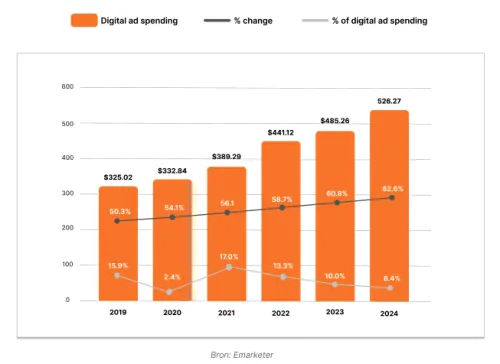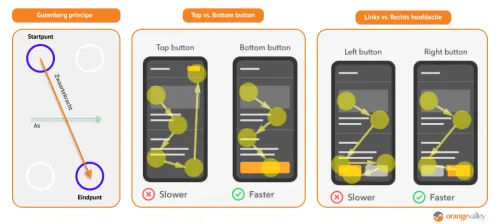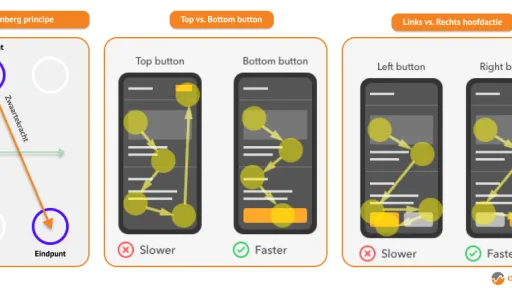Are you heavily reliant on Google and noticing that rising ad costs are impacting your revenue? It's no secret that competition on platforms like Google Ads and Meta Ads continues to increase, resulting in higher bids and higher costs per click. Due to these increasing costs, it is crucial to optimize every click and get the maximum return from your ad spend.
One of the most effective ways to achieve this is by investing in landing page optimization. An optimized landing page can make the difference between a successful conversion and a lost click.
We explain why a well-optimized landing page is so important for Advertising specialists right now, and how you can work with your CRO specialist to link the best-performing landing pages to your ads.

Image description: Digital advertising is becoming more expensive but Digital ad spend is becoming a smaller part of the total media budget.
Does the goal of your ad match the goal of your landing page?
A landing page is the webpage where a visitor lands after clicking a link to that page. This can happen from the (paid) search results of Google, an ad on social media, or from an email campaign. Therefore, it is crucial that a visitor finds the information or products they are looking for on this page, as shown in the ad. Often, specific landing pages are not included in the website menu because they are focused on certain (temporary) marketing campaigns.
Specific or generic, it is essential that your landing page meets the needs and expectations of your (potential) customers. The ultimate goal of a landing page for your paid campaigns and ads is not to convert all visitors of your landing page. Examples of conversions include buying an advertised product, contacting an advertised service, or signing up for an advertised newsletter.
Why don't you want all visitors on your landing page? You want a landing page that entices the right audience to take action. More quality traffic means more quality leads (and a higher chance of macro conversion), better quality scores, and ultimately a higher ROI on your ad spend. The more the visitor recognizes themselves on the page, the greater the chance they will take action.
Increase the ROI of your campaigns with conversion rate optimization (CRO)
Optimization involves making strategic improvements to various elements of a landing page to increase its effectiveness in achieving marketing objectives.
"The goal is to increase the conversion of campaign visitors by improving the user experience and aligning the page with the overarching marketing strategy."
By optimizing landing pages, companies aim to maximize the impact of their digital marketing efforts by ensuring that pages not only attract visitors but also persuade them to take the desired actions.
Avoid common mistakes on landing pages
When creating or choosing the best landing page, mistakes are often made that can cost you converters. Below we have compiled a list of the most common mistakes we often encounter as CRO specialists:
- Lack of relevance: It is crucial to create landing pages that are relevant to different search queries. If someone is searching for black shoes, they don't want to end up on a page with shoes of all colors.
- Too much chaos and no overview: It is important that your landing page remains clear. If there is too much offer or other distractions, the customer loses the overview. Make sure your landing page is focused on one goal!
- Missing a call-to-action (CTA): Sometimes call-to-actions are still missing on landing pages. As a result, visitors are not encouraged to take action, increasing the chance that they will leave. Visitors need to be stimulated to convert. For example, provide a clearly visible button with 'Contact us now'.
- Missing headlines and subheadings: Many people don't read entire texts but scan headlines and subheadings. If you don't use these, many people will miss essential information. Also, make sure your headlines and subheadings are catchy and interesting, so visitors want to view the rest of the information. Good headlines and subheadings in the form of H1, H2, and H3 are also important for SEO purposes.
Key elements for aligning and optimizing your landing pages
When providing an optimized landing page that perfectly matches your ad, various elements need to be integrated to ensure that the page effectively engages visitors and encourages them to take the desired actions. See it this way: The connection between your ad and your landing page is the bridge between a potential customer and a purchase. The stronger they are connected (the more relevant they are), the greater the chance of conversion.
-
Ad and keywords
Choose a landing page that closely matches your ad and keywords. If your keyword is discounted shoes and your ad promises shoes with a 20% discount, then customers should be able to find and buy shoes with that discount on your landing page.
-
Strong Call-to-Actions (CTAs)
Clear and compelling CTAs are essential for driving action. By using strategically placed and attractive CTAs, you can increase the conversion rate and encourage users to take desired actions. Your landing page should also reflect the call-to-action in your ad text. If your ad encourages customers to sign up for a free tour, you could prominently place a registration form on your landing page.
-
Easy to scan and navigate
Make it easy for customers to quickly take the action you want them to take - order your product, call your phone number, or ask a question. Don't make people search for information they might need. Don't clutter your site with too many ads or pop-ups.
It's a good idea to put important information at the top of the page. That way, it's immediately visible to customers when they land on the page, and they don't have to scroll down to see it.
By applying UX principles to your landing page, you make it easy for your visitors to quickly and intuitively find the right information and take appropriate action.

A/B Testing, Iterations, and Analytics
By regularly conducting A/B tests and evaluating the performance of different elements of the landing page, you can continue to optimize conversion rates. Iterative improvement ensures continuous growth and maximizes the effectiveness of the page. A/B testing provides a structured approach and predicts the long-term benefits for conversion rates of your landing pages, rather than temporary, incidental good performances.
By looking deeper into Analytics or Ads than page or campaign performance, you can also data-driven identify why your campaigns are performing well or not. Consider using segments such as breakdown by devices, or by new and returning users. Also, don't forget to use behavior analysis tools like Hotjar or Mouseflow to see which elements your landing page visitors do or do not click on. This is the easiest way to quickly identify which content resonates best with your visitors, and whether you should possibly move it to a better position on the page!
More Efficient Use of Budget
An optimized landing page can lead to lower costs per conversion, allowing you to get more value from your ad spend and increase your ROI. By investing in landing page optimization, you can use your ad budget more effectively and remain competitive, even in an environment with rising ad costs.
Conclusion
Landing page optimization is an important strategy for Advertising specialists to get the maximum return from ad spend, especially in a time of rising ad costs. By increasing relevance, improving user experience, increasing conversion rates, and controlling costs, you can take campaigns to a new height and maintain a competitive advantage. Keep striving for continuous improvement and innovation to get the most out of your ad spend.
Questions about Landing Page Optimization
How can I determine which elements of my landing page I should optimize?
Through A/B testing and analyzing user behavior, you can determine which elements of your landing page can be improved. Focus on elements such as the headline, images, forms, and CTAs.
How often should I optimize my landing pages?
Optimizing landing pages should be an ongoing process. Regular evaluation, A/B testing, and iterations are essential to improve the performance of your pages and maintain a competitive advantage.
How can I measure the impact of landing page optimization?
You can measure the impact of landing page optimization by tracking conversions, analyzing user behavior, and comparing performance before and after optimization. Use KPIs such as conversion rate, bounce rate, and average session duration to assess effectiveness.




